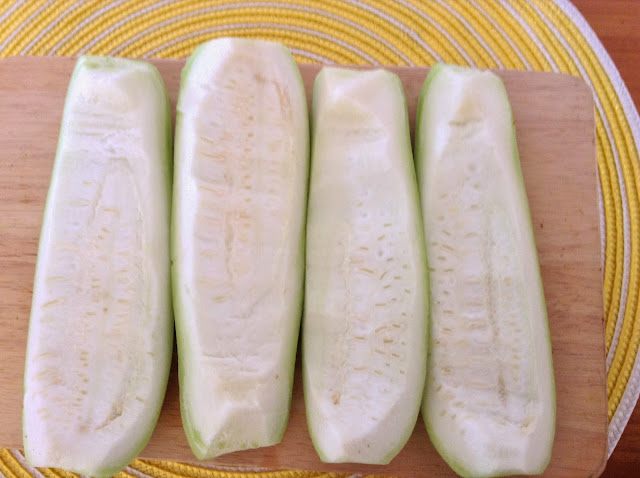 |
| Calabash sliced and core removed |
Calabash container with lid.
Source: Ndalama African Deserts Crafts
 |
| Calabash container with lid |
,_late_18th_century,_Hawaiian_Islands,_Kou;_carved.jpg) |
| Calabash Bowl - Source Wikimedia |
 |
| String instruments - Source wikimedia |
 |
| Sitar with resonator made from a bottle gourd. Source: Wikimedia |
The Chinese name for calabash is hulu and is found in southern Chinese food as soup and stir-fry. There is another variety found in China called Mao Gua or hairy squash because of its hairy skin. The tiny hairs can get embedded in the skin but is safe for adults to handle this variety of gourd. In Burma tender leaves are boiled and eaten with fermented fish sauce. In Japan dried marinated strips of calabash are sold in the markets and are used in making rolled sushi.
About 90% of the vegetable is made up of water and hence it is easily digested. Its spongy inside kernel is cut into small cubes and made into soups and curry.
Benefits:
1. Aids in digestion. It fights constipation, diarrhea and flatulence.
2. Diuretic and eases burning sensation when passing acidic urine. It alkalizes the urine. It helps in managing urinal track infection.
3. Juice is consumed for weight loss.
4. It contains calcium, magnesium, phosphorus, vitamins A, C and folate.
5. It is used in folk medicine for premature graying of hair and reducing inflammation.
6. In diabetes It helps in reducing sugar levels. It is also good for high blood pressure.
Caution
This vegetable may contain a harmful toxin called Tetracyclic Triterpenoid Cucurbitacins. This is evidenced by bitterness in taste. Always taste a small piece of this vegetable before cooking or juicing. If it is bitter, discard the whole vegetable. If you have consumed it unknowingly and have nausea, vomiting, and diarrhea symptoms then seek medical assistance immediately.
Nutrients found in calabash:
Nutritional value per 100 g
Energy 63 kJ (15 kcal)
Carbohydrates 3.69 g
- Dietary fiber 1.2 g
Fat 0.02 g
Protein 0.6 g
Thiamine (vit. B1) 0.029 mg (3%)
Riboflavin (vit. B2) 0.022 mg (2%)
Niacin (vit. B3) 0.39 mg (3%)
Pantothenic acid (B5 0.144 mg (3%)
Vitamin B6 0.038 mg (3%)
Folate (vit. B9) 4 μg (1%)
Vitamin C 8.5 mg (10%)
Calcium 24 mg (2%)
Iron 0.25 mg (2%)
Magnesium 11 mg (3%)
Manganese 0.066 mg (3%)
Phosphorus 13 mg (2%)
Potassium 170 mg (4%)
Sodium 2 mg (0%)
Zinc 0.7 mg (7%)
Source : USDA
When people see me buying calabash in the super market or market they ask me what do I do with it. I just tell them I make soup with it. I was thinking that people must be looking at this wonderful vegetable and walking away from it not knowing what to do with it. This prompted me to post this small collection of recipes.
Recipes:
Calabash (Bottle gourd) salad
Calabash (bottle gourd) stir-fry
Calabash (Bottle gourd) mild curry
Calabash Soup - Bottle Gourd Soup

No comments:
Post a Comment